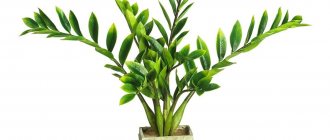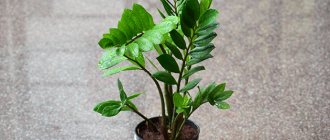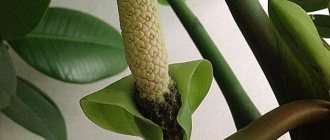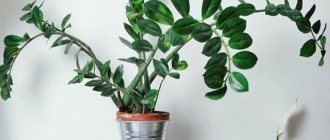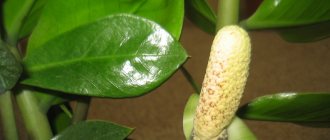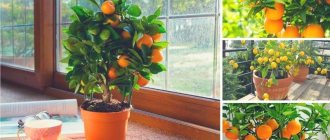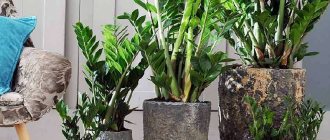Our advice will be useful to owners of Zamioculcas, as well as to those who are just planning to have a “money” pet. You will see that this plant does not require complex care. And we will tell you how to create favorable conditions for him.
Zamioculcas stands out among other indoor plants with its neat crown, impressive size and rich green color of leaves. But they love him not only for his spectacular appearance. There is a belief among flower growers that Zamioculcas helps its owners attract dollars. Therefore, along with the crassula (money tree), it took pride of place in many homes.
Meanwhile, not everyone knows how to properly care for a plant. Usually, it all comes down to the fact that Zamioculcas is unpretentious. But there are some features in caring for it.
Zamioculcas - description of the plant
Do you know plants such as monstera, dieffenbachia, syngonium or anthurium? So, Zamioculcas is a close relative of them and also belongs to the Araceae family. It began to be grown as a houseplant only at the end of the last century. And the wild relative of Zamioculcas, originally from tropical Africa, was first described in the first half of the 19th century.
Zamioculcas got its name from its resemblance to the Zamia plant from the cycad genus. By the way, zamia is common in America, on another continent, and it is also grown at home.
The common species in indoor culture is Zamioculcas zamiifolia.
Why did the plant attract flower growers so much? If you look at it carefully, you will notice that Zamioculcas is very unusual. Its thick stems are densely covered with glossy leathery leaves, sometimes resembling luxurious fans. The tubers of the plant are dense, but at the same time fragile. The dollar tree blooms very rarely and only in adulthood. The flower resembles an ear of corn, is rather inconspicuous and short-lived. So they grow the plant more for its greenery.
All parts of the plant are able to accumulate moisture, so Zamioculcas tolerates drought well. But the better the growing conditions of the flower, the juicier and brighter it will be.
Zamioculcas contains poisonous juice that can be dangerous for children, animals and allergy sufferers. When replanting, pruning, and propagating flowers, wear gloves. Make sure that the juice does not get on the skin and mucous membranes. In case of contact, rinse the affected area with plenty of water.
Types and varieties
There is one type of culture - Zamioculcas Zamielifolia. The remaining varieties of the plant are its subspecies or varieties. One of these is the Lanceolate Dollar Tree. This is a natural variety of flower. Its main difference is its long, lanceolate-shaped leaves.
Another variety is Zamioculcas Variegate, originally from Madagascar. This crop is larger: before placing it in the house, you need to be prepared that it will grow up to 1.5 m in diameter and height. It differs from Zamioculcas zamifolia in its leaves - they are green with white stripes.
There are several more subspecies. Among them, Zamioculcas Variegated - also has an unusual shape of leaves and their color - they are thin and elongated, with lemon spots on a green background. And Zamioculcas Dark Purple was brought from Korea. This flower is compact with shoots of a light green hue. But with age they darken.
What to do with Zamioculcas after purchase
To preserve the decorative appearance of zamioculcas, you need to properly care for it from the moment of purchase. Despite the temptation to immediately transplant the plant into a beautiful flowerpot, do not rush, but let the flower get used to the new conditions. By the way, it is better to buy a plant in the warm season so that it does not freeze on the way home.
When the plant has settled into its new room, after about 2-4 weeks, you can carefully transfer it into the pot along with the old lump of earth, and fill the gaps with fresh soil. This will reduce the stress of the procedure.
Choose a pot for transferring according to the size of the plant. The diameter of the new container should be 3-4 cm larger than the previous one. Ceramic and clay pots are suitable. It is better not to use plastic ones, because... the roots of the plant can break through them. The ideal shape of the pot is narrowed downwards. The container must have holes for water drainage.
Some gardeners, on the contrary, prefer plastic containers, because it is difficult to remove the plant from ceramic ones in the future. If you also love plastic pots, feel free to use them for transfer. Just make sure that the plant does not grow too much, and carry out a new transshipment in time.
In order for the dollar tree to recover faster after transplantation, adhere to the following rules:
- use light and fertile soil;
- be sure to make drainage using expanded clay, clay shards or broken bricks;
- do not bury the roots completely into the soil; they should protrude about 1 cm above the soil surface;
- do not shake off the soil from the earthen clod.
Be sure to wear gloves while working, as... Zamioculcas juice is poisonous.
The plant cannot be watered immediately after the procedure, otherwise it will die. Do this after about 7-10 days, when the zamioculcas adapts to the new pot. The first watering should completely wet the earthen ball. Drain the water that has drained into the pan. Next time, water the flower when the soil dries well.
Reproduction
To propagate the Dollar Tree, you can use various methods, because... To obtain a new plant, different parts of the flower are suitable. There are three vegetative methods. All of them are effective.
Leaflets and feathers
For this method, you can use any healthy leaf of the plant. It doesn’t matter whether it was deliberately chosen or broken off accidentally. The petiole of the leaf should be cut from the shoot at an angle of 45°.
Before planting, it must be dried in fresh air for 24-48 hours. For rooting, a small diameter pot filled with a warm soil mixture of peat and coarse river sand is suitable. To treat the cut area, you need to use crushed activated carbon or phytohormones.
Reproduction algorithm:
- Deepen the leaf in a clay pot into a damp substrate by a third.
- Create a greenhouse microclimate - To do this, cover the container with film or glass.
- Moisten the soil mixture a little.
Attention!
Rooting is a long process, so it is necessary to ventilate the greenhouse and remove condensation in a timely manner. The temperature should be constant - 22°C.
After 60-90 days, the old leaves will dry out, but small tubers will appear. They will produce new leaves in about 6 months. When they appear, they can be planted in a new pot.
But some gardeners do it differently. They break off a twig from Zamioculcas and drop it into a glass of liquid. After a while, roots form and they can be planted in a pot with prepared substrate. The leaf will take root if you don’t flood it, otherwise it will simply rot.
This method has strengths and weaknesses. The advantages include fast and good rooting, but the disadvantages are that only 2 leaves can be cut from an adult crop, in order to avoid damage to the decorative appearance of the tree.
Through a complex leaf
Using this method, you will be able to obtain strong seedlings that will definitely take root. But daughter tubers must form on the plant. When this happens, you need to separate the complex leaf from the mother tree along with the tuber bud.
The roots should be treated with activated carbon and dried a little. After this, plant it as a separate culture in a container with substrate. The tuber bud must be filled to the base of the leaf. Watering is permissible only 48 hours after the procedure, then you can begin normal care.
Dividing an adult plant
This method is the simplest and at the same time risky. It is only suitable for an adult and healthy plant. If the attempt is unsuccessful, you can destroy an existing crop without having time to propagate it. If Zamioculcas has a large and strong rhizome, then you can try it.
The procedure must be performed in the following sequence:
- Remove the plant from the container.
- Divide the rhizome, leaving at least one leaf bud on each part.
- Process all elements of the tuber. Perfectly crushed activated carbon is suitable for this.
- Dry for 24 hours.
- Plant in a pot. This must be done so that the tuber head is slightly visible from the soil mixture.
New flowers will grow very slowly. You must refrain from feeding for 60 days. During this time, water moderately.
Features of growing zamioculcas at home
The conditions for growing a dollar tree are quite simple. You will find basic information in our infographic. Save it so you always have it on hand!
Zamioculcas loves light and warmth, so it will feel good on western or eastern window sills and balconies. You can place the flower on the south side, but then provide it with good shading so that burns do not appear on the leaves. The plant will survive on a northern windowsill, in the shade, but may lose its rich green color. In summer he will enjoy “relaxing” in the garden or on the veranda. In winter, Zamioculcas often lacks light, so give it a place on the brightest windowsill.
How to water Zamioculcas
Water zamioculcas sparingly. The main rule: it is better not to top up than to overfill. From spring to autumn, make sure that water does not stagnate in the pan. In winter, water the plant as the soil dries to avoid rotting of the tuber and roots. Water only with warm, settled water, because... Zamioculcas does not like cold or even cool temperatures.
Despite the fact that zamioculcus stores water, you should not overdry it, otherwise the plant will shed its tops and lose its decorative appearance. Prolonged dryness can also cause spider mite infestation.
Wipe off dust on the leaves with a cloth as needed or give the zamioculcas a warm shower once a month.
As for spraying, it can only be carried out at very high air temperatures. The rest of the time, it is not advisable to do this, so as not to provoke yellowing of the leaves. To increase humidity, it is better to spray the air around the flower or place a container of water next to it.
Caring for a young plant
In order for the little Zamioculcas to grow well in an apartment, it needs to be provided with favorable conditions. Until the root system develops, the flower will not have beautiful leaves. Therefore, caring for an adult plant differs from caring for a seedling.
While the root system of zamioculcas is actively developing, the mother leaf blade or cuttings gradually turn yellow and wither. This happens because all the nutrients from them are used for the development of new growth.
By the time the first green leaves appear, the old parts of the plant have completely died off. leaves
If the indoor air is too dry, it is recommended to cover the plants with a glass cover from a jar or glass to maintain the necessary humidity. It is necessary to regularly open the sprouts for ventilation and check their condition.
When a plant develops a rosette of the first 2-3 leaves, it needs to be replanted in a medium-sized pot, which will allow the root system to grow, which will provide an opportunity for the development of full-fledged green mass.
Temperature and humidity
The plant is well adapted to home conditions and feels normal at normal room temperatures of +22–+25 degrees. A prerequisite is the absence of sudden temperature changes and drafts, from which it can shed its leaves and die.
As for humidity, a grown flower feels great at 50–60% and does not need additional moisture in the room.
Watering
Water the flower only after the substrate has completely dried. This is due to the fact that the plant is a succulent and stores a sufficient amount of water in its tissues. From excessive moisture, the root system of the plant can begin to rot, which will cause the death of the flower. In the hot season, 2 waterings per month are sufficient for Zamioculcas, provided the soil is completely dry. In addition to watering, the plant loves warm showers.
However, this procedure should not be performed so often, and the earthen substrate must be covered with film during the procedure.
Water the succulent moderately, only after the soil has completely dried. The flower tolerates mild drought more easily than waterlogging of the substrate, accumulating moisture in the tubers and leaves.
In summer, water 2-3 times a month, in winter - as the surface layer of soil dries completely.
After watering, wait 30–40 minutes and drain excess moisture from the pan. Stagnation of water leads to rotting of roots and tubers and death of the plant.
In addition, several times a year they arrange a shower for Zamioculcas, sprinkling the leaves with warm water. The soil is covered with film during the procedure.
Feeding
To ensure that young bushes have bright, glossy leaves, they are regularly fed with mineral complexes. The main period for applying fertilizers is from April to the end of November. In winter, the plant does not need fertilizing.
In early spring, when the succulent begins to actively grow greenery, the flower is sprayed with nitrogen-containing compounds.
Later, from about June–July, they switch to fertilizing with potassium and phosphorus fertilizers, reducing the dose of nitrogen.
An approximate feeding schedule is once every 20–30 days. Fine spray sprayers are used for spraying. Proper regular feeding promotes the growth of strong, beautiful leaves and healthy, dense petioles.
It is better to feed young zamioculcas using the foliar method. Spraying is carried out no more than once every 20 days, using any complex of mineral fertilizers for decorative foliage plants or succulents. As a result of this treatment, the leaves become beautiful and shiny, and their petioles become noticeably thicker.
In the autumn-winter period, when the plant is dormant, fertilizing is stopped and resumed only in mid-April.
Lighting
Young plants grow well only in well-lit places. However, the succulent does not tolerate direct sunlight. It’s a paradox, but a plant whose homeland is hot Africa feels better in light partial shade.
A lack of light is detrimental to zamioculcas, so a place with bright, diffused lighting is selected for the plant. It is convenient to use reflective screens made of white paper or foil.
Despite its African origin, Zamioculcas does not like direct sunlight. It is better to provide the plant with bright, but at the same time diffused light, by constructing an artificial screen for this or placing the flower in the penumbra of higher species. However, the lack of ultraviolet radiation affects the plant quite badly. The leaves of the flower become faded and lose their former decorative effect.
Formation of Zamioculcas
Usually the flower is not specially pruned, since it grows slowly and does not need to be molded. Only dry and damaged shoots are removed, as well as leaves with spots and traces of disease.
Partial pruning of the bush is allowed when it reaches excessive height. But not every gardener can grow a huge zamioculcas bush at home, so pruning may not even be necessary.
Transfer
Adult plants (from five years old) are replanted 2-3 times a year. Young succulents need annual replanting (transshipment). The procedure is planned for spring or early summer, having prepared the soil and pot in advance.
On a note! The container should be slightly larger than the old pot. Pots that are too large are not used, as moisture often stagnates in them and there is a risk of tuber rot.
The substrate is poor, for succulents, with the obligatory addition of soil disintegrants (vermiculite, river sand, perlite). The flower grows well in peat-sandy soil with the addition of a small amount of turf soil.
Replant by transshipment method, water after 3-4 days. To prevent fresh leaves from “falling apart” to the sides (they often grow large), special supports in the form of rings are placed in the pots.
How to feed Zamioculcas
The dollar tree quickly takes nutrients from the soil and will respond gratefully to regular feeding. During the growth period, from April to September, 1-2 procedures per month are sufficient. From October to March there is no need to fertilize the plant. The basic rule of fertilizing is the same as when watering: less is better than more.
Use ready-made store-bought preparations, for example, universal ones or for cacti and succulents. For Zamioculcas, half the concentration of the solution is enough. Water at the roots. You can also spray the flower with a urea solution (1 g per 1 liter of water) once a month.
If you have just transplanted a young plant, do not feed it until new leaves appear.
What you should know about the plant before propagating it
Zamioculcas (lat. Zamioculcas) is one of the most famous representatives of the Aroid family to the general public and is considered monotypic. This genus has only one species, which is called zamioculcas zamiifolia (lat. zamiifolia) and is a succulent, which is generally not typical for Araceae.
The plant's homeland is considered to be southeastern Africa, where the flower covers large areas with its lush greenery and, when a prolonged drought occurs, sheds its leaves, thus reducing the area of moisture evaporation.
How to trim zamioculcas
flowers.bitrix.ru
Despite its slow growth, zamioculcas requires regular crown formation and thinning. Otherwise, some of the leaves will not receive enough light and will turn yellow. Bare branches will not add decorative value to the flower. And if you prune regularly, you will get a luxurious green decoration for your interior.
Carry out pruning in spring or summer, but not in winter, when the tree has a dormant period. Dry and diseased parts of the plant, thickening stems and individual leaves must be removed. When replanting, also trim off some of the roots.
To work, you need a disinfected sharp pruning shears or a short knife. Scissors will not work because... they dampen the plant tissue. After the procedure, dry the sections and sprinkle with crushed coal.
When removing stems, leave the stumps near the surface of the soil, do not break them out, otherwise you will damage the tuber and roots. You can remove these stumps the next time you transplant and divide the zamioculcas.
How to transplant Zamioculcas
nasotke.ru
Like any other indoor plant, the dollar tree also needs to be replanted regularly. Young specimens are replanted annually, adults - as the roots grow, once every 3-4 years. As soon as they appear from the drainage holes, it’s time to transplant. If the plant is very old and large, it is enough to replace the top layer of soil with fresh one once a year. But this must be done carefully so as not to damage the root system.
The ideal time to transplant zamioculcas is spring. But if necessary, work can be carried out at other times of the year.
Dollar tree tubers are fragile, so replanting most often involves transshipment along with an earthen lump. Make up the rest of the soil from equal parts of turf, leaf, peat soil and sand. If possible, add humus. Choose a pot 3-4 cm wider than the previous one. Be sure to do drainage.
The procedure for transplantation is as follows:
- put on household gloves (you remember that zamioculcas juice is poisonous!);
- carefully remove the plant and inspect the roots;
- cut off the soft rotten parts of the roots with scissors;
- if the bush has grown greatly, divide the tubers and plant them in different containers, thereby rejuvenating the plant;
- remove stumps remaining after pruning;
- pour soil into the bottom of a new pot and place a flower in it;
- fill the gaps between the walls of the pot and the plant, compact the soil;
- do not bury the tubers too deeply, let them protrude about 1 cm above the soil surface;
- do not water the plant for 7-10 days, then water so that the entire earthen ball is saturated with water, and drain the excess water from the pan.
After transplantation, the dollar tree needs time to adapt. Since the flower is already growing slowly, its development will slow down even more after the procedure, but don't worry. Soon the zamioculcas will get used to the new conditions and will definitely produce new leaves.
Landing Features
Under natural conditions, Zamioculcas grows on very poor stony-sandy soils, in which water does not linger. Based on these features, you should choose the right soil for the plant. Soil requirements:
- Good water and air permeability.
- The acidity level is closer to neutral.
- Very loose.
- Quite nutritious.
Avoid having too much peat and clay in the soil. This will negatively affect the growth of Zamioculcas.
You can use a soil mixture for succulents, adding vermiculite, brick or expanded clay chips as a leavening agent. To prepare the mixture yourself you will need:
- Leaf soil - 1 part.
- Turf soil - 1 part.
- Coarse sand - 1 part.
- Peat - 1 part.
Be sure to sterilize the earthen mixture to disinfect it from pathogenic viruses and fungi. This can be done in two ways - treat the soil with boiling water or fry it in the oven.
Some evil tongues have dubbed Zamioculcas “the flower of celibacy.” Most likely, this happened due to the similarity of the plant with spathiphyllum, which is popularly called “muzhegon”.
How to propagate Zamioculcas
youtube.com
Zamioculcas can be propagated by any vegetative method: dividing the bush, cuttings or leaves. There is also a method of propagation by seeds, but it is rarely practiced in indoor floriculture. The easiest way to divide a dollar tree is when replanting. It will take a little more time to root the cuttings.
You can also take a healthy shoot that remains after pruning for propagation. Place it in water, wait for roots to appear, and then replant it in soil.
The most difficult method is leaf propagation, because... It will take about a year for new leaves to appear. After separating the leaf from the trunk, place it in a glass with wet sand and cover it with a transparent container, making a greenhouse. During this period, the leaf should grow roots. As soon as they appear, replant it in the soil and wait for new leaves to appear.
Reviews from flower growers
Later, Zamioculcas appeared in my house, after 5 years it has grown and now takes pride of place in the kitchen. The plant is about a meter in height, does not require special care, you do not need to water it often, once a week is enough, even if you forget to water it on time, nothing will happen to the plant. The plant is shade-tolerant, so it can be placed away from the window. But the more light the plant receives, the richer the color of the foliage.
I really like this indoor plant, the leaves are smooth, dense, shiny, and most importantly the plant is not whimsical.
Soll
https://otzyvy.pro/reviews/otzyvy-zamiokulkas-cvetok-bezbrachiya-35384.html
They gave me a flower, they said that it was a dollar tree and its presence in the room attracted prosperity to its owner.
Very beautiful bushes with succulent, leathery leaves are pleasing to the eye. Neither air humidity nor the degree of illumination have virtually any effect on it. The main thing is proper watering, otherwise the roots of the plant will rot. With proper care, the plant grows quickly and creates an aura of prosperity. Looks impressive both in pots on a leg and in simple tall pots. An excellent option for decoration and as a gift.
Sanchez
https://tutux.ru/opinion.php?id=14743
The leaves of the plant are beautiful, juicy and bright green. For a very long time it did not grow for me at all. I watered it very rarely, all according to the instructions. And then new shoots began to appear, they grew so quickly - miracles, they grow in leaps and bounds. Now Zamioculcas is again considering whether to grow further or not)) And I’m really looking forward to it) By the way, Zamioculcas is a great gift) I bought and gave to flower growers and simply, I always receive nothing but thanks in return. One bad thing: there are no more dollars) maybe we can expect a jump soon too)
el_ka Julia
https://flap.rf/Animals_and_plants/Zamioculcas/Reviews/6515114
Zamioculcas is a contradictory flower for me, my mother-in-law gave it to me, therefore, we have a neutral relationship
